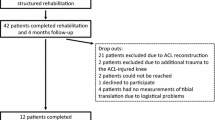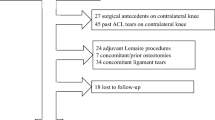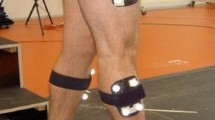Abstract
Purpose
To evaluate static and dynamic tibial translation before, 5 weeks after, and 5 years after anterior cruciate ligament (ACL) reconstruction. To explore whether static and dynamic tibial translation are correlated.
Methods
Ten patients undergoing quadruple hamstring tendon graft ACL reconstruction were evaluated before, 5 weeks after, and 5 years after ACL reconstruction. Sagittal tibial translation was measured during the Lachman test (static translation) and during gait (dynamic translation) using a CA-4000 electrogoniometer.
Results
Five years after ACL reconstruction, static tibial translation did not differ between knees (Lachman test 90 N and 134 N n.s.). In contrast, there was greater maximal anterior tibial translation during gait in ACL-reconstructed knees than in uninjured knees (5.5 ± 1.4 vs. 4.5 ± 1.6 mm, P = 0.028). There were no differences in static or dynamic tibial translation between the 5-year follow-up and before ACL reconstruction or between the 5-year follow-up and the 5-week follow-up. There were no correlations between static and dynamic tibial translation.
Conclusion
Although static tibial translation did not differ between knees 5 years after ACL reconstruction, dynamic tibial translation during gait was greater in ACL-reconstructed knees than in uninjured knees. Neither static nor dynamic tibial translation changed 5 years after ACL reconstruction as compared to before surgery and 5 weeks after surgery. Static tibial translation did not correlate with dynamic tibial translation.
Clinical relevance
This study indicates that although the knee is stable during static measurements, kinematics during gait is impaired 5 years after ACL reconstruction. This may affect the return to sport and risk of osteoarthritis.
Level of evidence
Case series, Level IV.

Similar content being viewed by others
References
Ahlden M, Sernert N, Karlsson J, Kartus J (2012) Outcome of anterior cruciate ligament reconstruction with emphasis on sex-related differences. Scand J Med Sci Sports 22(5):618–626
Andriacchi TP, Mundermann A, Smith RL, Alexander EJ, Dyrby CO, Koo S (2004) A framework for the in vivo pathomechanics of osteoarthritis at the knee. Ann Biomed Eng 32(3):447–457
Ardern CL, Webster KE, Taylor NF, Feller JA (2011) Return to sport following anterior cruciate ligament reconstruction surgery: a systematic review and meta-analysis of the state of play. Br J Sports Med 45(7):596–606
Chaudhari AM, Briant PL, Bevill SL, Koo S, Andriacchi TP (2008) Knee kinematics, cartilage morphology, and osteoarthritis after ACL injury. Med Sci Sports Exerc 40(2):215–222
Chmielewski TL, Ramsey DK, Snyder-Mackler L (2005) Evidence for differential control of tibial position in perturbed unilateral stance after acute ACL rupture. J Orthop Res 23(1):54–60
Chmielewski TL, Rudolph KS, Snyder-Mackler L (2002) Development of dynamic knee stability after acute ACL injury. J Electromyogr Kinesiol 12(4):267–274
Eastlack ME, Axe MJ, Snyder-Mackler L (1999) Laxity, instability, and functional outcome after ACL injury: copers versus noncopers. Med Sci Sports Exerc 31(2):210–215
Englund M (2010) The role of biomechanics in the initiation and progression of OA of the knee. Best Pract Res Clin Rheumatol 24(1):39–46
Gao B, Zheng NN (2010) Alterations in three-dimensional joint kinematics of anterior cruciate ligament-deficient and -reconstructed knees during walking. Clin Biomech (Bristol, Avon) 25(3):222–229
Georgoulis AD, Ristanis S, Moraiti CO, Paschos N, Zampeli F, Xergia S, Georgiou S, Patras K, Vasiliadis HS, Mitsionis G (2010) ACL injury and reconstruction: clinical related in vivo biomechanics. Orthop Traumatol Surg Res 96(8 Suppl):S119–S128
Heijink A, Gomoll AH, Madry H, Drobnic M, Filardo G, Espregueira-Mendes J, Van Dijk CN (2012) Biomechanical considerations in the pathogenesis of osteoarthritis of the knee. Knee Surg Sports Traumatol Arthrosc 20(3):423–435
Hurd WJ, Axe MJ, Snyder-Mackler L (2008) A 10-year prospective trial of a patient management algorithm and screening examination for highly active individuals with anterior cruciate ligament injury: part 2, determinants of dynamic knee stability. Am J Sports Med 36(1):48–56
Hurd WJ, Snyder-Mackler L (2007) Knee instability after acute ACL rupture affects movement patterns during the mid-stance phase of gait. J Orthop Res 25(10):1369–1377
Isberg J, Faxen E, Laxdal G, Eriksson BI, Karrholm J, Karlsson J (2011) Will early reconstruction prevent abnormal kinematics after ACL injury? Two-year follow-up using dynamic radiostereometry in 14 patients operated with hamstring autografts. Knee Surg Sports Traumatol Arthrosc 19(10):1634–1642
Jonsson H, Riklund-Ahlstrom K, Lind J (2004) Positive pivot shift after ACL reconstruction predicts later osteoarthrosis: 63 patients followed 5–9 years after surgery. Acta Orthop Scand 75(5):594–599
Kaplan Y (2011) Identifying individuals with an anterior cruciate ligament-deficient knee as copers and noncopers: a narrative literature review. J Orthop Sports Phys Ther 41(10):758–766
Kothari A, Haughom B, Subburaj K, Feeley B, Li X, Ma CB (2012) Evaluating rotational kinematics of the knee in ACL reconstructed patients using 3.0 Tesla magnetic resonance imaging. Knee 19(5):648–651
Kvist J (2004) Sagittal plane translation during level walking in poor-functioning and well-functioning patients with anterior cruciate ligament deficiency. Am J Sports Med 32(5):1250–1255
Kvist J (2005) Sagittal tibial translation during exercises in the anterior cruciate ligament-deficient knee. Scand J Med Sci Sports 15:148–158
Kvist J, Gillquist J (2001) Anterior positioning of tibia during motion after anterior cruciate ligament injury. Med Sci Sports Exerc 33(7):1063–1072
Kvist J, Gillquist J (2001) Sagittal plane knee translation and electromyographic activity during closed and open kinetic chain exercises in anterior cruciate ligament-deficient patients and control subjects. Am J Sports Med 29(1):72–82
Kvist J, Good L, Tagesson S (2007) Changes in knee motion pattern after anterior cruciate ligament injury—case report. Clin Biomech (Bristol, Avon) 22(5):551–556
Kvist J, Osterberg A, Gauffin H, Tagesson S, Webster K, Ardern C (2013) Translation and measurement properties of the Swedish version of ACL-Return to Sports after Injury questionnaire. Scand J Med Sci Sports 23(5):568–575
Li G, Rudy TW, Sakane M, Kanamori A, Ma CB, Woo SL (1999) The importance of quadriceps and hamstring muscle loading on knee kinematics and in situ forces in the ACL. J Biomech 32(4):395–400
Lohmander LS, Englund PM, Dahl LL, Roos EM (2007) The long-term consequence of anterior cruciate ligament and meniscus injuries: osteoarthritis. Am J Sports Med 35(10):1756–1769
Louboutin H, Debarge R, Richou J, Selmi TA, Donell ST, Neyret P, Dubrana F (2009) Osteoarthritis in patients with anterior cruciate ligament rupture: a review of risk factors. Knee 16(4):239–244
Markolf KL, Bargar WL, Shoemaker SC, Amstutz HC (1981) The role of joint load in knee stability. J Bone Joint Surg Am 63(4):570–585
Mohtadi N (1998) Development and validation of the quality of life outcome measure (questionnaire) for chronic anterior cruciate ligament deficiency. Am J Sports Med 26(3):350–359
Neuman P, Kostogiannis I, Friden T, Roos H, Dahlberg LE, Englund M (2012) Knee laxity after complete anterior cruciate ligament tear: a prospective study over 15 years. Scand J Med Sci Sports 22(2):156–163
Nyland J, Klein S, Caborn DN (2010) Lower extremity compensatory neuromuscular and biomechanical adaptations 2 to 11 years after anterior cruciate ligament reconstruction. Arthroscopy 26(9):1212–1225
Palmieri-Smith RM, Thomas AC (2009) A neuromuscular mechanism of posttraumatic osteoarthritis associated with ACL injury. Exerc Sport Sci Rev 37(3):147–153
Patel RR, Hurwitz DE, Bush-Joseph CA, Bach BR Jr, Andriacchi TP (2003) Comparison of clinical and dynamic knee function in patients with anterior cruciate ligament deficiency. Am J Sports Med 31(1):68–74
Paterno MV, Schmitt LC, Ford KR, Rauh MJ, Myer GD, Huang B, Hewett TE (2010) Biomechanical measures during landing and postural stability predict second anterior cruciate ligament injury after anterior cruciate ligament reconstruction and return to sport. Am J Sports Med 38(10):1968–1978
Pugh L, Mascarenhas R, Arneja S, Chin PY, Leith JM (2009) Current concepts in instrumented knee-laxity testing. Am J Sports Med 37(1):199–210
Roos EM, Roos HP, Lohmander LS, Ekdahl C, Beynnon BD (1998) Knee Injury and Osteoarthritis Outcome Score (KOOS)–development of a self-administered outcome measure. J Orthop Sports Phys Ther 28(2):88–96
Rudolph KS, Axe MJ, Buchanan TS, Scholz JP, Snyder-Mackler L (2001) Dynamic stability in the anterior cruciate ligament deficient knee. Knee Surg Sports Traumatol Arthrosc 9(2):62–71
Samuelsson K, Andersson D, Karlsson J (2009) Treatment of anterior cruciate ligament injuries with special reference to graft type and surgical technique: an assessment of randomized controlled trials. Arthroscopy 25(10):1139–1174
Snyder-Mackler L, Fitzgerald GK, Bartolozzi AR 3rd, Ciccotti MG (1997) The relationship between passive joint laxity and functional outcome after anterior cruciate ligament injury. Am J Sports Med 25(2):191–195
Tagesson S, Oberg B, Good L, Kvist J (2008) A comprehensive rehabilitation program with quadriceps strengthening in closed versus open kinetic chain exercise in patients with anterior cruciate ligament deficiency: a randomized clinical trial evaluating dynamic tibial translation and muscle function. Am J Sports Med 36(2):298–307
Tagesson S, Oberg B, Kvist J (2010) Tibial translation and muscle activation during rehabilitation exercises 5 weeks after anterior cruciate ligament reconstruction. Scand J Med Sci Sports 20(1):154–164
Tegner Y, Lysholm J (1985) Rating systems in the evaluation of knee ligament injuries. Clin Orthop Relat Res 198:43–49
Vergis A (1999) Sagittal plane knee translation in healthy and ACL deficient subjects. A methodological study in vivo with clinical implications. Linköpings Universitet, Linköping
Vergis A, Hammerby S, Gillquist J (2002) Fluoroscopic validation of electrogoniometrically measured femorotibial translation in healthy and ACL deficient subjects. Scand J Med Sci Sports 12(4):223–229
Williams GN, Chmielewski T, Rudolph K, Buchanan TS, Snyder-Mackler L (2001) Dynamic knee stability: current theory and implications for clinicians and scientists. J Orthop Sports Phys Ther 31(10):546–566
Acknowledgments
The authors thank the Orthopedic Department at the University Hospital, Linköping for cooperation. This study was supported by the Faculty of Health Sciences at Linköping University and by grants from the Swedish Center for Research in Sports.
Conflict of interest
The authors declare that they have no conflict of interest.
Author information
Authors and Affiliations
Corresponding author
Rights and permissions
About this article
Cite this article
Tagesson, S., Öberg, B. & Kvist, J. Static and dynamic tibial translation before, 5 weeks after, and 5 years after anterior cruciate ligament reconstruction. Knee Surg Sports Traumatol Arthrosc 23, 3691–3697 (2015). https://doi.org/10.1007/s00167-014-3279-8
Received:
Accepted:
Published:
Issue Date:
DOI: https://doi.org/10.1007/s00167-014-3279-8




